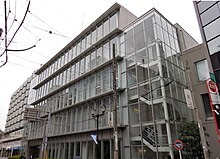You can help expand this article with text translated from the corresponding article in Japanese. (June 2024) Click [show] for important translation instructions.
|
 | |
 | |
Native name | 株式会社テレコム・アニメーションフィルム |
|---|---|
Romanized name | Kabushiki-gaisha Terekomu Animēshon Firumu |
| Company type | Subsidiary |
| Industry | Anime |
| Founded | May 19, 1975 |
| Headquarters | , Japan |
| Products |
|
| Parent | TMS Entertainment |
| Website | telecom-anime |
| Footnotes / references [1] | |
Telecom Animation Film Co., Ltd. (株式会社テレコム・アニメーションフィルム, Kabushiki-gaisha Terekomu Animēshon Firumu) is a Japanese animation studio founded on May 19, 1975.[1] The studio is a subsidiary of TMS Entertainment and is located in the parent company's headquarters building.[2][3]
Telecom Animation Film is a well-established studio known for its production cooperation on films produced by Tokyo Movie Shinsha, including the Japan-US co-production Little Nemo: Adventures in Slumberland, Hayao Miyazaki's Lupin III: The Castle of Cagliostro, and Isao Takahata's Jarinko Chie.[3][4] It is known in the industry as a prestigious studio, and has had many famous creators on its roster in the past, including Hayao Miyazaki, Isao Takahata, Yasuo Ōtsuka, who was their former tutor and animation director on their works, Kazuhide Tomonaga[a], who worked on the car chase scene in The Castle of Cagliostro, Nizo Yamamoto, art director at Studio Ghibli, and Yoshiyuki Sadamoto, character designer for Neon Genesis Evangelion.[6]
The studio has in-house staff of keyframes, inbetweenings, background art, direction, and production assistants who manage these tasks, allowing the general flow of production to be done in-house.[2] Unusually for an animation studio, Telecom has an in-house art department.[2] It is particularly known for its background art, and is highly regarded in the industry for its high level of technical ability. Its appeal lies in its high drawing power and 3D layout precision.[4][6][7]
It has participated in various productions in the form of production cooperation, and have been involved in the creation of background art for blockbuster films such as Hayao Miyazaki's The Castle of Cagliostro, Studio Ghibli films, Makoto Shinkai's Weathering With You, and Mamoru Hosoda's Belle.[6] While participating in the production of Studio Ghibli's Princess Mononoke, the studio was consulted about the lack of time for coloring and suggested digital painting, which led to Ghibli's introduction of computer graphics.[7]
- ^ a b "About Us". Telecom Animation Film Official Website (in Japanese). Retrieved June 17, 2024.
- ^ a b c Goto, Yurina (February 4, 2022). "アニメ映画『ブルーサーマル』が完成するまで 第三回 スタジオに潜入(1)" [Until the animated film "Blue Thermal" is completed: Part 3 Infiltrating the Studio (1)]. Animedia (in Japanese). iid. Retrieved June 17, 2024.
- ^ a b "The studio that created the animation production company 'Telecom Animation Film' infiltration coverage and 'LUPIN THE IIIRD Fujiko Minato's lie' looks like this". Gigazine. OSA. May 30, 2019. Retrieved May 30, 2024.
- ^ a b "東映『ブルーサーマル』押切P "映画館で空を飛ぶような体感"" [Toei "Blue Thermal" Oshikiri P "Feel like flying in the sky at the movie theater"]. Bunkatsushin (in Japanese). Bunkatsushinsha. March 8, 2022. Retrieved June 17, 2024.
- ^ "大塚康生さんは"アニメーションの大先生" ともに仕事をしたアニメーターと研究家が語る多角的な一面" [Yasuo Otsuka is a "great master of animation." Animators and researchers who worked with him talk about his many different sides]. Animehack (in Japanese). eiga.com. November 2, 2021. Retrieved June 17, 2024.
- ^ a b c Goto, Yurina (December 27, 2021). "テレコム・アニメーションフィルムの歴史と魅力" [The History and Appeal of Telecom Animation Film]. Animedia (in Japanese). iid. Retrieved June 17, 2024.
- ^ a b Goto, Yurina (February 4, 2022). "アニメ映画『ブルーサーマル』が完成するまで 第四回 スタジオ潜入(2)" [Until the animated film "Blue Thermal" is completed: Part 3 Infiltrating the Studio (2)]. Animedia (in Japanese). iid. Retrieved June 17, 2024.
Cite error: There are <ref group=lower-alpha> tags or {{efn}} templates on this page, but the references will not show without a {{reflist|group=lower-alpha}} template or {{notelist}} template (see the help page).